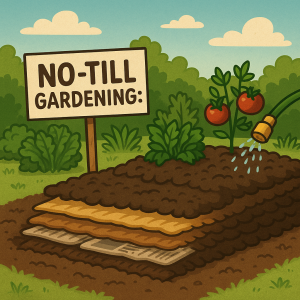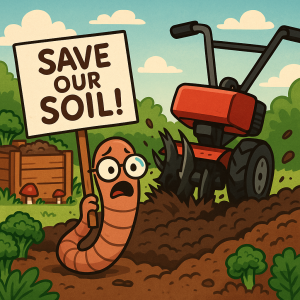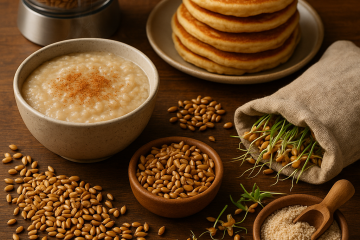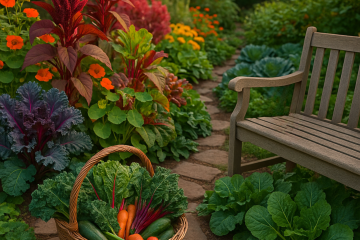
Is no till gardening better for you?
No-Till Gardening: Because Sometimes Your Soil Just Wants a Nap
…and that’s OK, Steve.
Before we dig in (yes, the puns are staying), let me be clear: I’m not suggesting that if you’re not doing no-till, you’re gardening wrong. Far from it. I’m a big believer in the Mittleider method, and it continues to be my go-to approach for serious, high-yield gardening—especially when you need consistency, control, and productivity, even in rough or unconventional growing conditions. It’s flexible, powerful, and it works just about anywhere, from a rooftop to a bathtub filled with sawdust and dreams.
But one of the beautiful things about self-reliance is that it doesn’t live in a box. It lives in a lifestyle. So while the Mittleider method might be the power tool in your gardening kit, no-till can be the gentle hand trowel—subtle, effective, and worth considering, especially when you’re thinking long-term soil health, resilience, and sustainability. Whether you’re building a second garden plot, experimenting with soil-building, or just tired of soil that needs therapy every spring, no-till could be a solid sidekick.
Why Even Consider No-Till Gardening?
No-till gardening is built on a bold and radical theory: Your soil knows what it’s doing—if you’d just let it. Instead of constantly stirring, flipping, and churning the earth like a caffeinated pastry chef, no-till gardening leaves the soil structure intact and lets nature take the lead. Think of it as more of a partnership than a performance.
Underneath your feet lies an entire unseen workforce—a bustling biological city of earthworms, microbes, and fungi that work full-time (without benefits, mind you) to break down organic matter, aerate the soil, trap nutrients, and basically make your garden a five-star resort for roots. When we till, we not only break up that natural soil structure, we decapitate worm burrows, shatter fungal highways, and send beneficial microbes running for the hills. It’s like hosting a dinner party and then demolishing the dining room with a leaf blower.
One of the most unsung heroes of no-till is the mycorrhizal fungi network. These fungal strands act like a subterranean fiber-optic cable system, connecting plant roots, transferring nutrients, water, and even chemical signals. Plants use it to help each other out (yes, plants gossip too), warn each other of pests, and even assist struggling neighbors. Tilling? That’s the equivalent of cutting the garden’s Wi-Fi. Suddenly your tomatoes aren’t getting the group texts anymore.
What’s more, no-till gardens hold water better. The mulch and compost layers act like a sponge, helping retain moisture even during scorching summer stretches. That means less time watering and more time sitting in a shady chair watching zucchini grow like it’s trying to win a trophy.
And let’s talk about weeds. Tilling flips up dormant weed seeds and brings them right to the surface like they’re auditioning for “America’s Got Taproots.” No-till smothers those seeds with mulch, cutting off light and oxygen before they ever get the chance to make a comeback tour. Add to that the ongoing organic matter breaking down, and you’ve got a self-feeding, self-healing system that just keeps getting better year after year.
How to Start a No-Till Garden (Without Triggering Your HOA or Throwing Out Your Back)
Step one: Choose your space.
Find a sunny spot—6 to 8 hours of daylight. Doesn’t matter if it’s currently lawn, gravel, or a weed patch you’ve been side-eyeing since last July. No-till doesn’t judge.
Step two: Smother the chaos.

No till gardening preserves the ideal environment for growing
Lay down cardboard or newspaper (skip the glossy stuff, Steve) directly on top of what’s already there. Overlap it generously so weeds don’t peek through like nosy neighbors. Water it to get things soft and soggy—it helps kickstart decomposition.
Step three: Build your garden lasagna.
Stack your layers like a compost-powered casserole. Here’s the short-order cook version:
-
2–4 inches of compost or aged manure
-
2–6 inches of straw, shredded leaves, or grass clippings
-
More compost if you’ve got it
-
A thick mulch topping—wood chips, bark, or straw
This layered beauty will start to break down into a rich, worm-friendly soil buffet while you get to feel smug about not having broken a sweat.
Step four: Water like it’s a spa day.
Soak your layers to settle them into place and keep decomposition moving. You’re hydrating your garden bed, not hosting a mud wrestling match, so don’t overdo it.
Step five: Plant now or later.
If it’s off-season, let it rest and cook down. If it’s go-time for tomatoes, simply cut or move aside mulch and plant into the compost layer. The roots will dig in as the rest breaks down.
Step six: Keep it mulched. Always.
This is the one no-till commandment: Never let your soil go bare. Bare soil invites weeds, moisture loss, and pest drama. Top it up with mulch any time you see it getting thin.
A Tool, Not a Theology
No-till gardening isn’t about doing it the “right” way. It’s about doing it a right way—one that complements your goals, your land, and your back muscles. I still stand by the Mittleider method for efficient, high-yield growing. But for building deep, rich, living soil? For reducing water and weed stress? For creating a backup garden that doesn’t require weekly acrobatics and an IV drip of ibuprofen? No-till is a worthy companion in your preparedness toolkit.
Try it. Tweak it. Tuck it in with a blanket of straw and whisper, “Grow, little plot, grow.” The worst-case scenario? You’ve got more compost. The best? You get a lush, forgiving garden that feeds your body, your pantry, and maybe even your soul.
Now, go forth—and resist the rototiller. Your soil will thank you with every crunchy carrot and juicy tomato it sends your way.

